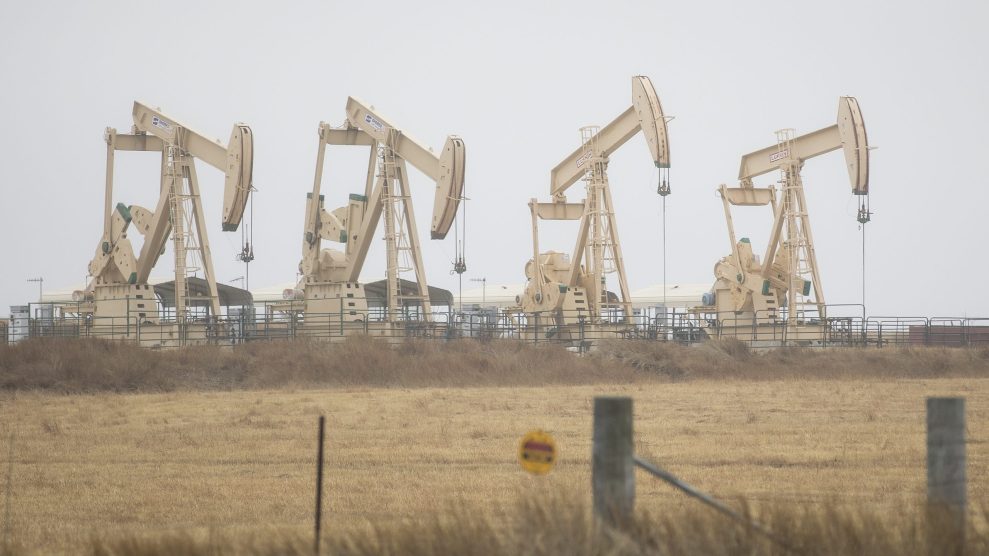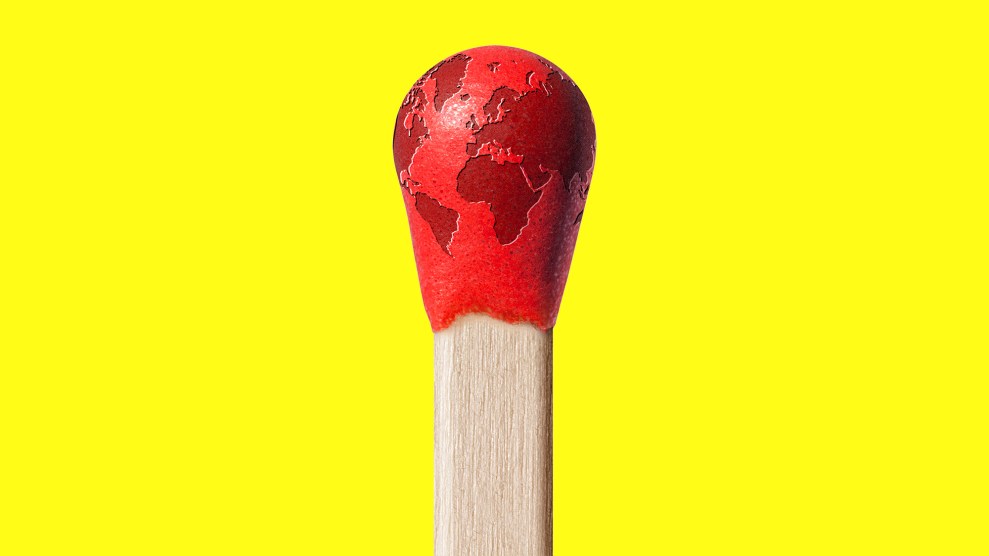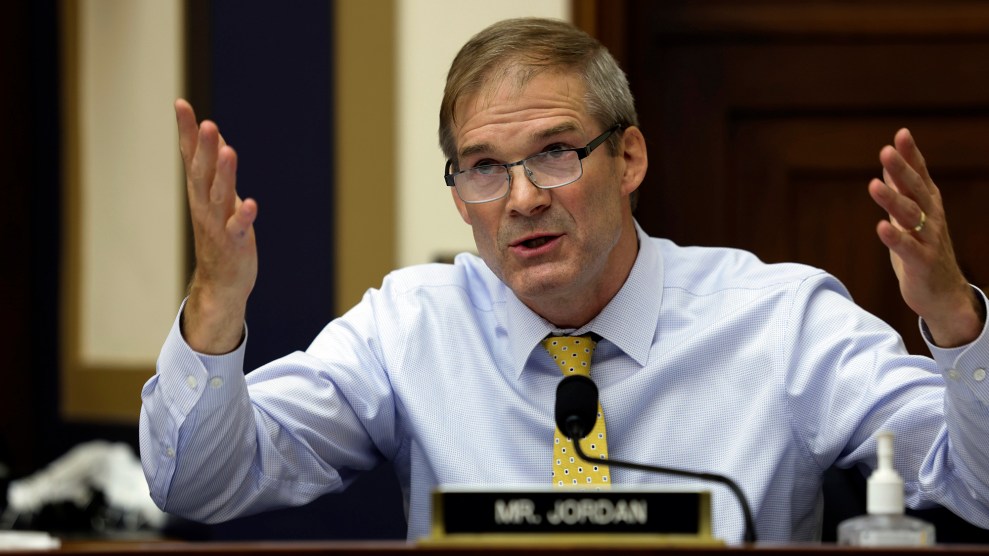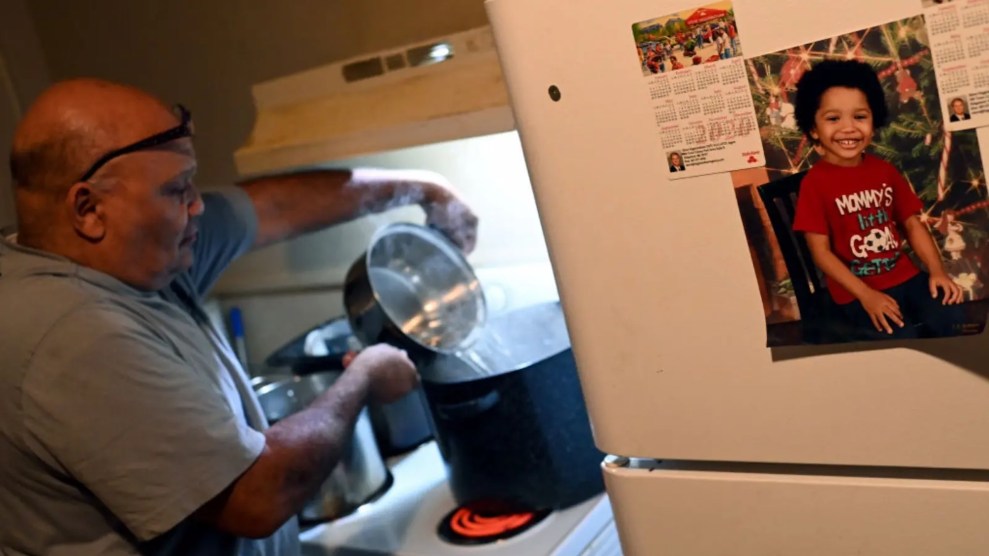
Jigar Shah, director of the Department of Energy's loan programs office in Washington, D.C. Mother Jones; US Energy Department/Wikimedia
This story was originally published by the Guardian and is reproduced here as part of the Climate Desk collaboration.
Deep in the confines of the hulking, brutalist headquarters of the US Department of Energy, down one of its long, starkly lit corridors, sits a small, unheralded office that is poised to play a pivotal role in America’s shift away from fossil fuels and help the world stave off disastrous global heating.
The department’s loan programs office was “essentially dormant” under Donald Trump, according to its head, Jigar Shah, but has now come roaring back with a huge war chest to bankroll emerging clean energy projects and technology.
Last year’s vast Inflation Reduction Act grew the previously moribund office’s loan authority to $140 billion, while adding a new program worth another $250 billion in loan guarantees to retool projects that help cut planet-heating emissions. Which means that Shah, a debonair former clean energy entrepreneur and podcast host who matches his suits with pristine Stan Smiths, oversees resources comparable to the GDP of Norway: all to help turbocharge solar, wind, batteries and a host of other climate technologies in the US.
With a newly divided Congress stymieing any new climate legislation in the foreseeable future, Shah has emerged as one of Washington’s most powerful figures in the effort to confront global heating. Shah says such focus on him is “hyperbolic” but the White House is pinning much of its climate agenda on an office that barely had a dozen people when Shah joined in March 2021. It now has more than 200 staffers as it scrambles to distribute billions in loans to projects across the US.
John Podesta, senior adviser to Joe Biden on clean energy, said that the loans office is “essential to the effective implementation” of the administration’s goal to eliminate planet-heating emissions by 2050. “Jigar is laser-focused on working with all levels of government, project sponsors, and affected communities to deliver on that mission and realize results for the American people,” Podesta said.
“There’s a lot of responsibility that’s been put on to this office, clearly Congress gave us those additional resources,” said Shah, who has been busy connecting the newly enriched loans office with all corners of the emerging clean energy economy, not just wind farms and solar operators.
Shah said there was “some rust on the gears” among those tasked with reanimating the office following the tenure of Trump, a president so wary of even the most lo-fi environmental technology that he complained energy efficient lightbulbs made him look orange and became fixated upon the weak flushing ability of water-saving toilets.
But the clean energy loans now appear to be gaining momentum, with 125 current applications seeking $119 billion worth of loans to act as the “bridge to bankability,” as Shah puts it. About $2.5 billion has been given to Ultium Cells to manufacture lithium-ion batteries for electric cars in three states, $700 million has gone to a project that will mine lithium in Nevada—despite concerns this will negatively affect a rare flower in the region—and more than $500 million for the world’s largest facility creating “green” hydrogen, to be used to fuel trucks and industry, in Utah.
“We’ve left no stone unturned,” said Shah, who says he understands the mindset of entrepreneurs, having previously founded the renewable energy companies SunEdison and Generate Capital, as well as being the co-host of The Energy Gang podcast.
“We’ve called every one of those companies that have been labeled climate tech, whether it’s green chemicals, green cement, green steel,” he said. “It doesn’t matter who it is, we’ve called them and said, ‘Hey, let me introduce you to the loan programs office, so now we can help.’”
This new prominence is set to provoke a stinging Republican backlash, however. To conservatives, the loans office, which was founded in 2005, is forever tarred by the much-criticized decision during Barack Obama’s administration to loan $535 million to Solyndra, the California solar firm, only for the company to file for bankruptcy two years later, in 2011.
The huge new financial arsenal at the office’s disposal risks “Solyndra on steroids,” according to Cathy McMorris Rodgers, the incoming Republican chair of the House energy committee. A group of Republicans led by Rodgers have said the new loan authorities “raise questions about increased risks of waste, fraud and abuse, especially if the administration uses the program for its rush-to-green agenda.”
Shah, who could well be hauled in front of Rodgers’ committee this year, said GOP scrutiny is “totally ordinary and expected” and that the loans office is a more rounded and mature entity than during the Obama years when it still, a year before Solyndra collapsed, notably backed an upstart car company called Tesla with a $465 million loan. The failure rate of 3.3 percent for its loans is about that you’d expect from a prudent bank lender rather than a profligate waster of taxpayer money, Shah points out.
Some level of risk taking will be required if the US is to quickly scale up the sort of clean energy technologies that are regularly devised by Americans but can struggle to get support from investors, Biden’s allies argue. “Shah will pick some winners and some losers, that’s how it works,” said Paul Bledsoe, a former Clinton White House climate change adviser, now with the Progressive Policy Institute.
“If you don’t pick any losers you haven’t taken on enough risk of picking a big winner. They key is a to pick a few really big winners and with this office there have been more Teslas than Solyndras, by a long shot.”
Bledsoe said that the US has traditionally not funneled large amounts of public money into commercializing clean energy technology and “right about now we are wishing we did,” due to the emergence of China as the global leader in solar panel, wind turbine and battery production.
The US, after years of happily offshoring such activities, is looking to kickstart domestic manufacturing via the Inflation Reduction Act incentives. “We have to harden our domestic supply chains because we can’t replace oil-based transportation with critical minerals-based transportation and be dependent on foreign nations when we can process those minerals ourselves,” said Bledsoe.
While the cost of wind and solar power has fallen dramatically over the past decade—to the point new renewable projects are often cheaper than continuing with existing fossil fuel plants—and electric vehicle sales boomed globally last year, there remains a knot of different causes of the climate crisis still awaiting solutions that are at the tipping point of mass adoption.
Heavy trucking, shipping and aviation that can’t run yet on batteries require a new fuel source, perhaps hydrogen (the Department of Energy is actively looking to fund clean-running aircraft) that isn’t as polluting as oil. Industrial processes such as steel and cement manufacturing are nowhere near to being emissions free.
Even if the US entirely cleans up its electricity grid, it will need thousands of miles of new transmission lines and integrated large-scale batteries to store and distribute the renewable energy to where it’s needed. The Department of Energy, meanwhile, is putting billions of dollars into efforts to remove carbon directly from the atmosphere or capture it at source and bury it underground, although this barely scratches the surface – a recent report estimates that 1,300 times more CO2 removal from new technologies is needed globally by 2050 to avoid breaching a 2C rise above pre-industrial temperatures.
The key to much of this is, as John Kerry, the US climate envoy, put it recently, “money, money, money, money, money, money, money.” Jessica Jewell, an expert in clean energy at Chalmers University, said that even though the cost of solar and wind “has fallen tremendously over the last couple of decades, growth of low-carbon technologies is still not fast enough to reach our climate goals and has yet to make a significant dent in hard-to-abate sectors like industry and transportation.”
“There are many clean energy technologies which are still ‘pre-commercial’ which means they cannot compete without significant support,” Jewell added. “Without these technologies, even the growth of wind and solar power may stall or don’t have the required effect on bringing emissions down.”
Shah said he is confident major strides are being made on hydrogen fuels and that that it is a “foregone conclusion” that 100m tons of CO2 will be captured and buried by US industry due to carbon management investments.
But he thinks much more needs to be done in nuclear, such as the development of small modular reactors, as well as advanced geothermal, where steam from reservoirs of underground hot water is harnessed to run power plants. He frets that the US is short of a million tradespeople to engineer the mass electrification of everything that currently runs on fossil fuels, and that the transmission lines aren’t being built quickly enough.
“I think there’s a lot of work to be done in some of those areas,” Shah said. “When you think about the enormity of the challenges that we’re faced with, that are all prerequisite ingredients to a successful climate deployment, there’s a lot of work to do.”
Shah, who is 48, was born in Gujarat, India, and moved to the US when be was one. He now has a seven-year-old son of his own who adds a certain urgency to his father’s work. “He is asking me tougher questions every month—he says, ‘Hey, are you doing enough on these issues? Hey, why is there exhaust coming out of the car in front of me? Why don’t they have an electric car?’ I’m like, ‘We’re working on that,’” Shah said.
Aside from the pressure exerted by Republicans—and his son—Shah also has to grapple with the existential imperative of a ticking climate timebomb. The last eight years were the hottest ever reliably recorded on Earth but they will appear almost frigid in the future if the US, the world’s biggest ever carbon emitter, doesn’t give up its fossil fuel habit.
“You feel that pressure,” Shah said. “I hold myself to outcomes. I don’t hold myself to best efforts. I feel like there’s a lot of people who are like, ‘Well, I gave it my best.’ And I was like, ‘Well, I mean, that’s not enough. You either have reduced climate emissions or you haven’t.’
“And it does weigh on you. I mean, I sleep well at night, I recognize that good sleep is a good thing. But I do put a lot of pressure on myself and my team, because I think we are up to the challenge. And I think that if not us, then who?”















